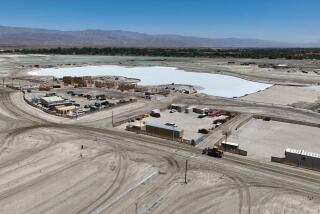Taos Grapples With Tourism, Commercialism
TAOS, N.M. â The view from Tony Reynaâs hand-built adobe house hasnât changed much in half a century.
Horses graze in broad meadows, hawks soar and swoop, mountains rise unscarred to meet a brilliant blue sky.
But a scant mile or two from peaceful Taos Pueblo, traffic piles up on the narrow, two-lane street that is the townâs main artery.
Galleries and gift outlets long ago replaced the general stores and barbershops that Reyna used to visit when he rode his horse along muddy roads to the townâs plaza.
A popular warm-weather tourist destination for decades, Taos has become a dual-season destination because of the ski resort 20 miles away. It also is home to actress Julia Roberts and scores of others with money to spend on second homes.
The town swells and shrinks to the rhythms of tourism, creating a sprawl that is eating into neighboring villages and climbing up mountainsides.
âThe only thing thatâs preserved in a natural state is our land,â said Reyna, 81, who has twice been governor of the 35-square-mile pueblo on the townâs north edge.
The modest shop with handsome, Indian-made art that Reyna runs from his home depends on tourist traffic. But Reyna doesnât want more tourists in Taos.
âWhat Iâm concerned about is the future,â he said. âWeâre afraid of an influx of people coming in.â
Thatâs one reason Reyna objects to a proposed expansion of the municipal airport, one of several major growth issues Taosenos have struggled with in recent years. A new runway would allow larger, private jets, and perhaps charters someday.
Another worry: that vibrations from bigger planes would cause deterioration in the centuries-old, multistory pueblo dwelling the Spanish conquistadors first saw in 1540.
Located on a vast, high plain cut by the Rio Grande gorge, at the foot of stunning mountains, fast-growing Taos is a town of about 6,200 in a county of about 25,600.
It logged 416,000 tourist visits last year. In the last four years, the demand for hotel rooms has risen 40%.
To some extent, it shares the woes of other resorts: low-paying, seasonal jobs; rising prices for land and housing; crowded roads; overburdened infrastructure; friction between newcomers and old-timers.
Like many other Taos residents, Maria Lewis holds two jobs, spending about 27 hours a week behind the counter at a small coffee shop and another 10 to 15 as a cocktail waitress.
âYou have to do what Iâve heard referred to as the Taos financial shuffle,â said Lewis, 36.
Tourism pays her bills, but she says the sheer crush of people can be oppressive.
âIt changes the energy of the town a lot,â she said. âThe energy here is very clear and very spiritual and thatâs why people choose to live here. When the tourists come, it gets more material. They sort of bring their place here.â
In Taos County, the per capita income in 1995 was barely $15,000; the average household income is estimated at less than $25,000. For that household, an $80,000 house is considered affordable--but the median cost of a home in the county is $162,000.
âRight now, itâs close to impossible for someone my age to buy a piece of property in Taos,â said Marlene Torres, 30.
Torres works for a local economic development agency and earns close to $20,000--not bad by local standards, she says. She and her husband, who has a minimum-wage maintenance job, bought a mobile home.
âThatâs the only affordable housing for us,â said the mother of two. âI would rather have my own house and at least an acre of property so my kids could have space to run around in, and we could have some privacy.â
While many residents of the predominantly Hispanic area are still hanging onto the land their families have owned for generations, rising property taxes make that more difficult.
âWe have a lot of people who are land-rich and cash-poor,â said the countyâs planning director, David DiCicco.
With an unemployment rate of 14%, some residents have housing but canât find jobs.
On the fringes of Taos--except on pueblo land--sprawling new $500,000 homes dot the sagebrush plains and mountainsides.
âTheyâre an eyesore,â said Telesfor Gonzales, a liquor store owner and former county commissioner, gesturing at the homes. âIâve hunted that area since I was a small kid. Now itâs posted. I feel enclosed, more and more . . . and a lot of people feel the same way.â
Real estate broker David Buck says that although prices have risen steadily over the 25 years heâs been there, theyâre still considerably lower than almost any other resort area.
âI think Taos is reluctant to change--be that a traffic light, or be that a large development, or be that a paved road versus a dirt road,â said Buck, whose plans a few years ago for a $40-million development of homes, shops, an art center and a hotel were killed by local opposition. âItâs kind of a conservative area.â
For all its problems, Taos is no Aspen or Vail--and residents are quick to say they donât want it to be.
Airport-expansion opponent Cliff Bain says Taosâ relative isolation--three hours from the nearest big airport, in Albuquerque--has saved it thus far.
Although Taos has changed, âthe majority of people up here still are locals with ties to the land. Every year itâs more of a struggle, but they havenât been displaced yet,â he said.
Bain worries that more visitors ultimately mean more residents gobbling up land, changing the face of the largely agricultural villages nearby.
âThere are a lot of people pretty fierce about not letting this go the way of other resort communities,â he said.
More to Read
Sign up for The Wild
Weâll help you find the best places to hike, bike and run, as well as the perfect silent spots for meditation and yoga.
You may occasionally receive promotional content from the Los Angeles Times.






